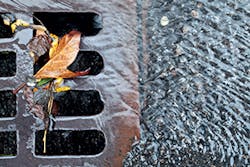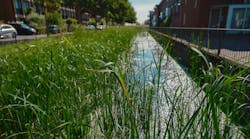As is the case with any active construction site, sediment control is a primary concern on the job sites where Greg McCormick works. He is the water pollution control manager for Riverside Construction Co. in southern California.
Until recently, the company had created protective barriers around storm drain inlets using gravel bags along the gutter at the edge of the pavement. “What happens is that the gravel bags would always get run over, and as an inspector, I’d have to say ‘Fix this.’ Every week I would have to go out to the construction site and say ‘Fix this,’” says McCormick. “With crushed gravel bags, the gravel probably ends up in the gutter, and I’m hoping the guys are picking it up.”
As is the case with any active construction site, sediment control is a primary concern on the job sites where Greg McCormick works. He is the water pollution control manager for Riverside Construction Co. in southern California.
Until recently, the company had created protective barriers around storm drain inlets using gravel bags along the gutter at the edge of the pavement. “What happens is that the gravel bags would always get run over, and as an inspector, I’d have to say ‘Fix this.’ Every week I would have to go out to the construction site and say ‘Fix this,'” says McCormick. “With crushed gravel bags, the gravel probably ends up in the gutter, and I’m hoping the guys are picking it up.”
[text_ad]
The company recently began using ERTEC Environmental Systems’ Top Guard products for drain inlet protection. McCormick used ERTEC inlet protection products on a job starting in October 2014 on which the company had to shift traffic close to the gutter. In ensuing months, McCormick noted that not only had none of the units been damaged, but they had filled up with sediment to the same degree that check dams would. Capturing sediment is his primary goal with the ERTEC products.
McCormick favors using GR8 Guard for many catch basin and overside drain applications. GR8 Guard is a four-layer system designed to reduce sediment flow into grated storm drain inlets in paved areas. The integrated filter is designed for high flows, with the outer berm allowing water to rise nearly 1.5 inches before reaching the filter, causing heavier particles to settle.
Protecting catch basins and overside drains can be difficult in heavily trafficked areas, but the GR8 Guard doesn’t present a problem for vehicles “because they’re so tucked away as compared to the gravel bags,” he says.
“I use those for catch basins if I do have a grate,” notes McCormick. “Those are the ones that tend to be out in traffic because the drain will pretty much go to the edge of the pavement, so you push the GR8 anywhere from 22 to 26 inches out from the face of the curb. I’ve been using them where there is a swale that runs a couple thousand feet alongside a project and there are three drop inlets; I place one in each of those.”
The GR8 Guard filters stormwater above the ground for ease of visual inspection and maintenance. It is designed for easy installation, longevity, and traffic resistance, and can be reused. The grate does not need to be removed during installation or cleaning.
“I use them specifically to what they’re recommended for, and in my opinion they work really well,” notes McCormick. “The only situation I’ve had is that no matter what kind of inlet protection you use, if there is too much flow, they stop working in the sense that they don’t drain quickly enough to keep water from going out into the traffic.
“These have small holes that help spill into the drain. I’ve had a couple of situations where I’ve had to remove them, and the nice thing is I’m not removing 15 gravel bags, I’m removing two GR8 Guards and flipping them over so they are essentially an L shape on the curb,” he says. “I leave them there and tell my guys to put them back when they’re done. I’m not moving a bunch of bags in the rain.”
On a recent construction job, McCormick chose to use Curb Inlet Guard, Drop Guard, and Combo Guard. Curb Inlet Guard is designed to reduce sedimentation into curb inlets through the use of an integrated filter with a 2-inch vertical height to allow water to bypass during high-flow events. The HDPE units have built-in brackets to keep them from collapsing into the storm drain and can be overlapped as needed to fit all sizes of openings. A hydrocarbon absorption option is available for new asphalt applications. The system is designed to last the life of the project and is UV-stable. It also is designed for ease of installation and cleaning and can be reused.
Drop Guard is designed to reduce sediment flowing into drop inlets on unpaved or soft-scape surfaces. The one-size-fits-all product allows water flow-through but reduces velocity while filtering particles. Drop Guard’s 7-foot recyclable HDPE panels—available in heights of 12 and 15 inches—are trenched to a depth of 4 inches, wrapped around drain inlets, and held together with wood stakes. The filter, designed for concentrated flows, is self-cleaning after post-storm sediment buildup is removed.
Combo Guard is a four-layer system designed to reduce sedimentation into combination curb and grate inlets as part of a comprehensive sediment control approach. The integrated filter’s 2-inch vertical height allows water to bypass during high-flow conditions. The system installs aboveground and is designed for easy installation, visual inspection, and maintenance. Combo Guard is designed to fit most combination storm drains. It is resistant to damage from vehicular traffic. The recyclable HDPE system can be reused.
[text_ad use_post='27664']
McCormick says the ERTEC inlet protection products are easy and quick to install. He keeps them in his truck, and when he sees an inlet that needs protection, “I park my truck on the side of the road, open the back, take the two or three I need out, set them down and walk away. I don’t even have to tell the superintendent to fix it, which is awesome because I don’t have to keep telling my guys to pick up crushed gravel bags.”
Riverside Construction Co. gets paid from $150–$250 per inlet to protect it for the life of the job, notes McCormick. That was another factor in choosing ERTEC products. “They cost $50 an inlet, or $100 if there’s two separate guards we have to put in,” says McCormick. “Even so, the guys never have to go back, and labor is $60 an hour.”
He says if he has to do maintenance on the ERTEC products when they get loaded with sediment, he will pick them up and swap them with clean ones he carries in his truck, then go back to the yard where he will beat them with a shovel and wash them down with a hose. His goal is to be able to reuse the products after he removes them from one job and use them on the next.
Check out Forester Media's directory for detailed information from our partners in erosion control: erosion control devices, geosynthetics, sediment control devices and soil erosion. For additional information from our erosion control partners, visit our Erosion Control Directory.
He also is pleased that he has not been told by any entity for which his company works that the ERTEC inlet protection products are not an approved BMP. “My contracts don’t define how to protect inlets,” he adds. “That leaves it wide open for us as long as I’m demonstrating that I’m capturing sediment—you can’t really quantify it, it’s more visual thing—and they work and the agency sees them.”
McCormick was pleasantly surprised one day when he discovered at a site where there had been a leaky excavator that the ERTEC product was capturing fluid. “These products have ¼-inch felt in them and I could smell the petroleum,” he says. “They were inadvertently capturing hydraulic fluid or oil. A gravel bag would do the same, so it worked in that way as well.”
McCormick uses the ERTEC products in conjunction with other BMPs such as check dams and a “reduced” version of a gravel bag upstream to provide an effective pretreatment BMP.
The company recently began using ERTEC Environmental Systems’ Top Guard products for drain inlet protection. McCormick used ERTEC inlet protection products on a job starting in October 2014 on which the company had to shift traffic close to the gutter. In ensuing months, McCormick noted that not only had none of the units been damaged, but they had filled up with sediment to the same degree that check dams would. Capturing sediment is his primary goal with the ERTEC products.
McCormick favors using GR8 Guard for many catch basin and overside drain applications. GR8 Guard is a four-layer system designed to reduce sediment flow into grated storm drain inlets in paved areas. The integrated filter is designed for high flows, with the outer berm allowing water to rise nearly 1.5 inches before reaching the filter, causing heavier particles to settle.
Protecting catch basins and overside drains can be difficult in heavily trafficked areas, but the GR8 Guard doesn’t present a problem for vehicles “because they’re so tucked away as compared to the gravel bags,” he says.
“I use those for catch basins if I do have a grate,” notes McCormick. “Those are the ones that tend to be out in traffic because the drain will pretty much go to the edge of the pavement, so you push the GR8 anywhere from 22 to 26 inches out from the face of the curb. I’ve been using them where there is a swale that runs a couple thousand feet alongside a project and there are three drop inlets; I place one in each of those.”
The GR8 Guard filters stormwater above the ground for ease of visual inspection and maintenance. It is designed for easy installation, longevity, and traffic resistance, and can be reused. The grate does not need to be removed during installation or cleaning.
“I use them specifically to what they’re recommended for, and in my opinion they work really well,” notes McCormick. “The only situation I’ve had is that no matter what kind of inlet protection you use, if there is too much flow, they stop working in the sense that they don’t drain quickly enough to keep water from going out into the traffic.
“These have small holes that help spill into the drain. I’ve had a couple of situations where I’ve had to remove them, and the nice thing is I’m not removing 15 gravel bags, I’m removing two GR8 Guards and flipping them over so they are essentially an L shape on the curb,” he says. “I leave them there and tell my guys to put them back when they’re done. I’m not moving a bunch of bags in the rain.”
On a recent construction job, McCormick chose to use Curb Inlet Guard, Drop Guard, and Combo Guard. Curb Inlet Guard is designed to reduce sedimentation into curb inlets through the use of an integrated filter with a 2-inch vertical height to allow water to bypass during high-flow events. The HDPE units have built-in brackets to keep them from collapsing into the storm drain and can be overlapped as needed to fit all sizes of openings. A hydrocarbon absorption option is available for new asphalt applications. The system is designed to last the life of the project and is UV-stable. It also is designed for ease of installation and cleaning and can be reused.
Drop Guard is designed to reduce sediment flowing into drop inlets on unpaved or soft-scape surfaces. The one-size-fits-all product allows water flow-through but reduces velocity while filtering particles. Drop Guard’s 7-foot recyclable HDPE panels—available in heights of 12 and 15 inches—are trenched to a depth of 4 inches, wrapped around drain inlets, and held together with wood stakes. The filter, designed for concentrated flows, is self-cleaning after post-storm sediment buildup is removed.
Combo Guard is a four-layer system designed to reduce sedimentation into combination curb and grate inlets as part of a comprehensive sediment control approach. The integrated filter’s 2-inch vertical height allows water to bypass during high-flow conditions. The system installs aboveground and is designed for easy installation, visual inspection, and maintenance. Combo Guard is designed to fit most combination storm drains. It is resistant to damage from vehicular traffic. The recyclable HDPE system can be reused.
McCormick says the ERTEC inlet protection products are easy and quick to install. He keeps them in his truck, and when he sees an inlet that needs protection, “I park my truck on the side of the road, open the back, take the two or three I need out, set them down and walk away. I don’t even have to tell the superintendent to fix it, which is awesome because I don’t have to keep telling my guys to pick up crushed gravel bags.”
Riverside Construction Co. gets paid from $150–$250 per inlet to protect it for the life of the job, notes McCormick. That was another factor in choosing ERTEC products. “They cost $50 an inlet, or $100 if there’s two separate guards we have to put in,” says McCormick. “Even so, the guys never have to go back, and labor is $60 an hour.”
He says if he has to do maintenance on the ERTEC products when they get loaded with sediment, he will pick them up and swap them with clean ones he carries in his truck, then go back to the yard where he will beat them with a shovel and wash them down with a hose. His goal is to be able to reuse the products after he removes them from one job and use them on the next.
Check out Forester Media’s directory for detailed information from our partners in erosion control: erosion control devices, geosynthetics, sediment control devices and soil erosion. For additional information from our erosion control partners, visit our Erosion Control Directory.
He also is pleased that he has not been told by any entity for which his company works that the ERTEC inlet protection products are not an approved BMP. “My contracts don’t define how to protect inlets,” he adds. “That leaves it wide open for us as long as I’m demonstrating that I’m capturing sediment—you can’t really quantify it, it’s more visual thing—and they work and the agency sees them.”
McCormick was pleasantly surprised one day when he discovered at a site where there had been a leaky excavator that the ERTEC product was capturing fluid. “These products have ¼-inch felt in them and I could smell the petroleum,” he says. “They were inadvertently capturing hydraulic fluid or oil. A gravel bag would do the same, so it worked in that way as well.”
McCormick uses the ERTEC products in conjunction with other BMPs such as check dams and a “reduced” version of a gravel bag upstream to provide an effective pretreatment BMP.


